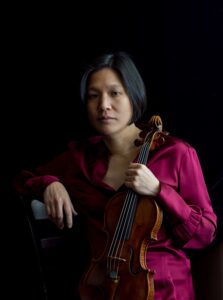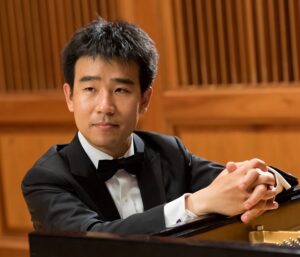Between the years 1797 and 1812, Ludwig van Beethoven wrote 10 violin sonatas: pieces in three or four movements, composed for violin and pianoforte — each an endeavor of the imagination, says pianist Jiayan Sun. He and violinist Elizabeth Chang will perform the full cycle on Friday, Dec. 29 and Saturday, Dec. 30 at the Wellfleet Public Library: sonatas 1, 2, 3, 7, and 10 on Friday and 4, 5, 6, 8, and 9 on Saturday.

The performances are overdue: 2020 was the 250th anniversary of Beethoven’s birth, and Chang says many performances of his works planned for that year but were canceled because of the pandemic. This year, both Chang and Sun are taking sabbaticals from their respective institutions: Chang is professor of violin at UMass Amherst and teaches violin and viola in the pre-college division of the Juilliard School, and Sun is assistant professor of music and associate chair for performance activities at Smith College. They are embarking on a concert tour of the Beethoven cycle.
Performing the sonatas requires imagination, says Sun, partly because the duo play instruments different from those of Beethoven’s time. “In particular,” he says, “the piano has evolved drastically.” The sostenuto pedal, a feature of the modern piano that allows for the easy sustaining of notes, was invented in 1844, 17 years after Beethoven’s death. Modern pianos are bigger and louder than those Beethoven played and composed for. For Sun, a key question is: “How do we convey the essence of these works with the instruments that we have today?”
For Chang and Sun, adapting to the requirements, suggestions, and musical landscapes of each sonata is essential. The sonatas not only vary in key and personality, but they also require the performers to evolve and change roles.
“For the first eight sonatas,” says Sun, “Beethoven still had one foot in the older world.” Those pieces were partially tailored for domestic music-making by amateurs, he says. “The ladies in the households would play the piano, and the men would play the violin — perhaps not very well.”
The ninth and tenth sonatas, says Sun, were written for professional musicians: the ninth for the violinist George Polgreen Bridgetower and the tenth for Pierre Rode. “Beethoven was imagining himself as the pianist,” says Sun, “although by the tenth sonata, he no longer had the ability to perform.”
In the earlier sonatas, says Chang, the violin assumed “a sort of obbligato part” — a necessary but largely supportive voice. By the ninth sonata, she says, “both instruments were at the peak of virtuosity.” The tenth is an example of extraordinary equality of dialogue between violin and piano: the violin offers a four-note phrase, and the piano responds. In the second movement, the piano utters a serene hymn, and the violin responds with a wandering melody that agrees.
In performing all the sonatas back to back, although not always in the order of their composition, Chang and Sun are especially aware of the communication among the pieces — how “the language of the sonata changes,” Chang says, but also the ways Beethoven handles tempo, key, and meter.
Three of the sonatas, numbers 2, 6, and 9, are in A Major. “A Major is certainly a friendly key for the violin,” says Sun. But the choice also speaks of Beethoven’s creative energy and innovation, he says, “that he could create such different works, convey this gamut of expression, even when these works are composed in the same key.”
The second sonata feels determinedly gleeful, lighthearted — even prankful. In its busy conversation between violin and piano, it departs from the seriousness with which Beethoven often wrote. The sixth sonata was written in 1801, just a year before Beethoven wrote the Heiligenstadt Testament, a letter to his brothers expressing despair at his impending deafness, his contemplation of suicide, and his decision to keep living in order to compose more music. The sonata feels as if it has something important to say — the piano and violin engage in a mature conversation, each seeming to listen closely to the other and then respond with understanding.

The ninth sonata feels like something new. Beethoven’s title page describes it as a “sonata for the pianoforte and violin obbligato, written in a very concertato style, almost like a concerto.” The piece begins with introductory chords played by the violin alone — their length and harmonic qualities feel distinctly soloistic. The violin ends its introduction, and the piano enters with equal presence before the two instruments engage in a vigorous Presto.
Though the ninth stands out, all the sonatas are significant historically. They’re personally significant, too. Chang is the artistic director of Green Mountain Chamber Music Festival in Vermont and artistic director and cofounder of the Lighthouse Chamber Players, based on Cape Cod. “Chamber music is one of the most stimulating ways to make music,” she says.
Sun puts it this way: “In the case of the sonatas, we’re talking about the two hands of the pianist and then the violin voice. In terms of mathematics, the number of possibilities for that combination seems finite. But in actuality we are talking about an infinite number of possibilities of how the voices can be combined and confronted.”
In rehearsal, Chang says, though they’ll converse about things like ambiguity in the written markings and issues of pacing and articulation, she and Sun do more listening than talking. Sun agrees. “For us,” he says, “it seems that since music is the art of listening, it becomes even more pointed that, when we make music together, it’s the listening that takes priority. It’s through listening to ourselves, then listening to each other, and listening to what we create together that we evolve with these pieces.”
He feels the pieces growing and changing, too. “We always think about these pieces as towering masterpieces,” he says. “But as musicians, it’s more about these pieces being part of us.” They’re like his children, he says. But it’s more intimate even than that. “Children, after birth, are no longer part of anyone’s body,” he says. “But with a piece of music, that stays with us forever, until we no longer exist.”
Masterpieces
The event: Elizabeth Chang and Jiayan Sun perform Beethoven’s 10 violin sonatas
The place: Wellfleet Public Library, 55 West Main St.
The time: Friday, Dec. 29 and Saturday, Dec. 30, 5 p.m.
The cost: Free
